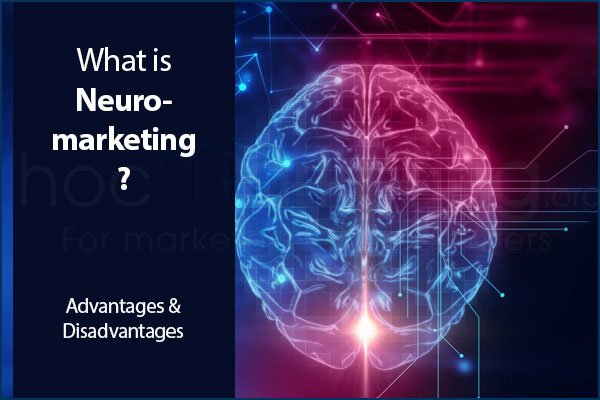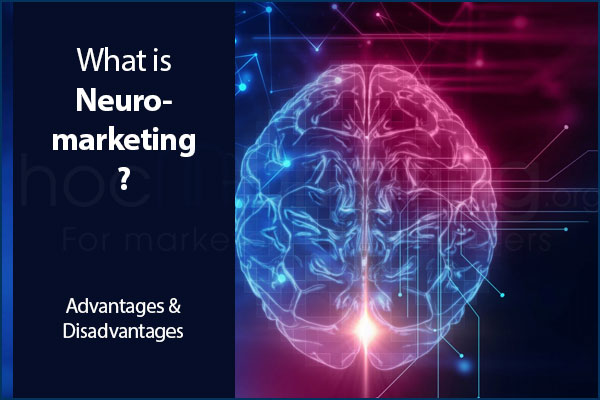
What is Neuromarketing? Advantages & Disadvantages

Artificial Intelligence and Neuromarketing are everywhere, now. This article reviews the advantages and disadvantages of neuromarketing in comparison to traditional marketing.
Artificial Intelligence and Neuromarketing are everywhere, now. This article reviews the advantages and disadvantages of neuromarketing in comparison to traditional marketing.
What is neuromarketing?
Neuromarketing is the study of how consumers' brains react to marketing, using both medical and scientific techniques.
Today, neuromarketing is entering into its fourth decade of being an emerging marketing tool. Primarily designed to help marketers research customer behavior in order to develop more effective marketing strategies, this can be applied in many different markets including advertising and selling.
There's more to marketing than simply determining what customers will buy. Neuromarketing uses such effective methods as triggering emotions and patterns, probing minds without demanding or any kind of participation from the customer, and learning how they use their senses and make decisions (because they do!). Insights into how people make purchases plays an important role in understanding how to differentiate your brand through successful marketing.
Neuromarketing suggests that both emotional and rational thinking exist simultaneously. Just like the neuroscience which helps to understand the function and structure of the brain, neuromarketing offers a number of mechanisms related to neuroscience like decision making, reasoning, memory, emoting, etc. before you buy a particular product.
Usage of Neuromarketing
Neuromarketing is an emerging area of marketing with much promise. It looks into how emotions and attention can affect customer satisfaction and loyalty. This can lead to more than just short-term satisfaction through word-of-mouth or even negative word of mouth. There is evidence that even highly satisfied customers may be returned if the relationship ends.
Did you know that approximately sixty percent of your overall marketing efforts should be focused on the brain? Neuromarketing experts use a variety of tools to measure just how engaged your target audience is by scanning their brains in order to pinpoint which parts are activated. They also monitor and track what's working, so you're getting optimum results, every time.
The responsive advertisement is designed to include excitement, passion, humor, emotional attachment and unconscious thought.
Techniques used in neuromarketing strategies
1. FMRI (Functional Magnetic Resonance Imaging)
Brain activity is measured by the amount of oxygen in a person's blood. When this level starts to drop, it indicates that the brain is underperforming or engaging in difficult tasks.
2. MRI (Magnetic Resonance Imaging)
By having a maximum entropy system, it leads to the customer understanding better what is being conveyed by the advertisements.
3. EEG (Electroencephalography)
EEG technology can measure and record the electrical activity of your brain.
4. MEG (Magnetoencephalography)
A cortical magnetic field sensor can provide important information about the brain and its neural activity without any invasive devices, such as the FMRi.
5. SST (Steady State Topography)
It's used to record and measure brain activity. It offers a high temporal resolution, which allows it to be used in neuromarketing research, which is concerned with the advertisement on TV.
6. Respiratory rate:
Men have a heart rate of 66 beats per minute. For women, it’s between 70 and 100 beats per minute.
7. Heart rate
This is how many times the heart beats over a minute. This is done by measuring the dilations of the pupils to the visual stimulus.
8. Galvanic skin response or skin conductance:
It's used to detect the changes occurring on the skin as a result of moisture levels in the surrounding area.
9. Eye tracking method
Eye-tracking software is a method of psychological measurement which relies on tracking the eyes.
10: Voice Analysis
The knowledge gathered from the sleep extension can be quite useful in measuring psychophysiological stress that comes out of the voice.
Examples of Neuromarketing
Cola and Pepsi are both completely identical, but what helps customers choose between them is their preference for the product's brand. This preference is formed with the help of neuromarketing. Researchers found that people tend to consume one over the other based on how it makes them feel.
Then researchers investigate and found that cultural messages lead to guide our perception of products, resulting in changing buying decisions. One experiment is done blindfolded, and the other was done by knowing what beverage was what, with the help of which researchers observed their brain activity.
While conducting a study on the effects of beverage choice, researchers found that activation of the ventromedial prefrontal cortex is greater when participants drink Pepsi.
When given the option to choose between cola, volunteers saw increased brain activity in the hippocampus, midbrain and dorsolateral prefrontal cortex (among other structures) when consuming coke over Pepsi. The brain's focus is nostalgia or emotional connection with this drink of choice.
Looking at these results, researchers found that coke drinkers are fans of the brand and remember it more vividly than the taste. This is because timing plays a bigger role than taste, so maintaining emotional memories is key.
Advantages of Neuromarketing
NeuroMarketing is a new and exciting tool to help uncover customer behavior. It helps companies understand the insights so their marketing resonates with their customers.
Neuromarketing determines which marketing methods will work best for a particular customer by getting to the root of human behavior and needs.
Real-time marketing can now be a reality by conducting neuromarketing research; this process not only tries to determine what people want: it also observes eye movements, facial expressions and shifts of the mouse cursor. By determining whether these responses are coming from the conscious or unconscious mind, markets can now reach people with true desires rather than just taking a survey.
The software tools available online today provide depth and quality insights for less cost, especially when compared to traditional means of research.
Neuromarketing allows companies to understand consumer reactions by tapping into the unconscious mind. When using this technique, they'll also be able to understand buying decisions and comprehend customer decision-making patterns.
Customers know how they feel when they have a particular product in the marketplace. As a result, brain mapping can be used to produce reliable data.
By linking material related to physiological reactions of the moment with particular videos from website and packaging design, in-depth analysis of customer reaction’s emotions, as well as improvement suggestions on what to avoid or contain, can be found.
Disadvantages of Neuromarketing
1. Ethical concerns
Brain-imaging technology, such as MRI and fMRI scans, is used by companies to learn about customer behaviour. While neuromarketing can help in ways psychologists cannot, its focus on patterns of behaviour is less than what a psychologist might do.
2. Specific skills are required
The more specific skills allow insight to be achieved. In the past, it was required to have a scientific background but now with advancements in technology it's so easy to understand reports.
3. Equipment is expensive
Neuromarketing and the related cost are somewhat expensive.
4. Lack of privacy
The individual is not insured from leakage of data.
Conclusion
There's a massive demand for marketers who can prove they understand their customers, and that's exactly what we do. With our diverse and holistic products we're proven to give customers what they want. We'll help you find the solution to your challenges, just as fast as your customers need it.
Neuromarketing is necessary because it's the field of study that uses medical technology to know how consumers react to particular brands and slogans.
Now with the help of brain activity measuring tools such as EEG, marketers will get closer and more personal to their consumers. While this technology might be powerful, it must only be used for marketing purposes in a ethical and honest way.
Since neuroresearch is considered universal, neuromarketing will soon be out of the picture for those who want to explore it. In the future, scientists will not be encouraged to explore this area with such a high price tag.
It is necessary to orchestrate various factors such as neurology, psychology and marketing in order to design effective advertising campaigns. Culture is a very important societal factor that is responsible for behavior; therefore implementing culture can improve the effectiveness of your marketing and advertisements.














